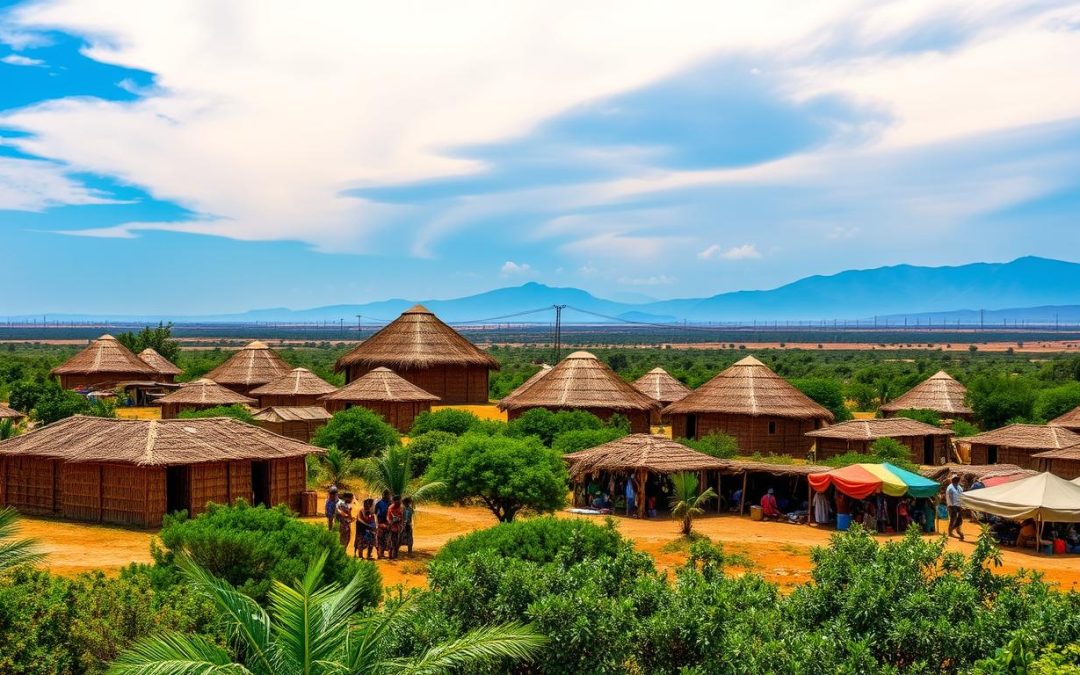Have you ever wondered how a country with over 120 languages manages to communicate effectively? In Chad, linguistic diversity is not just a challenge—it’s a vibrant cultural asset that bridges communities across this African nation.
Chad’s language landscape is a fascinating tapestry of official and indigenous languages. French and Arabic serve as the country’s official languages, while Chadian Arabic emerges as a powerful lingua franca connecting diverse ethnic groups across the region.
With approximately 13.67 million people speaking a remarkable array of languages, Chad represents a unique linguistic ecosystem. French dominates in urban centers like N’Djamena, while Chadian Arabic facilitates commerce and communication for 40-60% of the population.
Key Takeaways
- Chad has two official languages: French and Arabic
- Over 120 indigenous languages are spoken in the country
- Chadian Arabic serves as a critical lingua franca
- Language diversity reflects Chad’s rich cultural heritage
- Urban and rural areas have distinct language usage patterns
Understanding Chad’s Linguistic Landscape
Chad is a place of amazing language diversity. Over 100 languages mix together, creating a rich cultural story. This shows how history, migrations, and colonial times have shaped how people talk.
The language scene in Chad is a window into its deep culture. It blends African roots with colonial touches, making it both complex and interesting.
Historical Language Development
Chad’s language history is filled with cultural meetings. Important moments include:
- Keeping indigenous African languages alive
- Arab language impacts from old Muslim empires
- French becoming part of the mix during colonial times
Geographic Distribution of Languages
Languages in Chad vary by region. Each area has its own language traits:
- Southern areas: Mostly indigenous African languages
- Northern regions: Arabic and Chadian Arabic are big
- City areas: French is used more
Cultural Impact on Language Use
In Chad, language is more than just talking. It shows who you are and where you come from. The mix of ethnic groups, religions, and history makes language a living thing.
“In Chad, every language tells a story of survival, adaptation, and cultural resilience.”
Getting to know Chad’s languages helps us see its social tapestry. Here, talking is not just about words. It’s a way to share culture and connect with others.
Official Languages: French and Arabic in Modern Chad
In Chad, French and Arabic are key colonial languages. They are vital in government, education, and talking to each other. Knowing their importance helps us understand Chad’s complex culture.
French is a main language in big cities like N’Djamena. Men in the south mostly speak it. About 15% of Chadians use French as their main language. It’s important for school and work.
- French is used in most educational institutions
- Widely spoken in urban areas
- Primary language of government documentation
Arabic, especially Standard Arabic, has a big impact. Around 615,000 people speak it. Chadian Arabic is used by 40-60% of the population for business and everyday talk.
“Languages are the roadmaps of a culture. They tell you where its people come from and where they are going.” – Rita Mae Brown
French and Arabic show Chad’s deep history and culture. But, over 120 local languages also exist. This shows Chad’s amazing language variety.
The Rise of Chadian Arabic as a Lingua Franca
In Chad, Chadian Arabic has become a key way for different groups to talk to each other. It started with nomadic herders and now millions of Chadians use it every day.
Origins and Evolution
Chadian Arabic began in the 17th century with herders in Chad. The Baggara Arabic dialect was key in its development. It came from Arab traders, nomads, and local people mixing their languages.
- Originated among pastoral communities
- Developed through cultural exchanges
- Influenced by regional trading networks
Current Usage Statistics
Now, Chadian Arabic is the main language for most people in Chad. About 40-60% of the population speaks it well. It helps people from different backgrounds talk to each other.
Regional Variations
Chadian Arabic has different forms in different places. The Baggara Arabic in southern Chad is especially interesting. It shows how language changes with culture and history.
“Language is the roadmap of a culture. It tells you where its people come from and where they are going.” – Rita Mae Brown
Learning Chadian Arabic helps us understand Chad’s culture. It shows how language is more than just talking. It’s about identity and connection.
Indigenous Language Families in Chad
Chad is home to over 120 indigenous African languages. These languages belong to three major families. This shows the country’s rich cultural heritage.
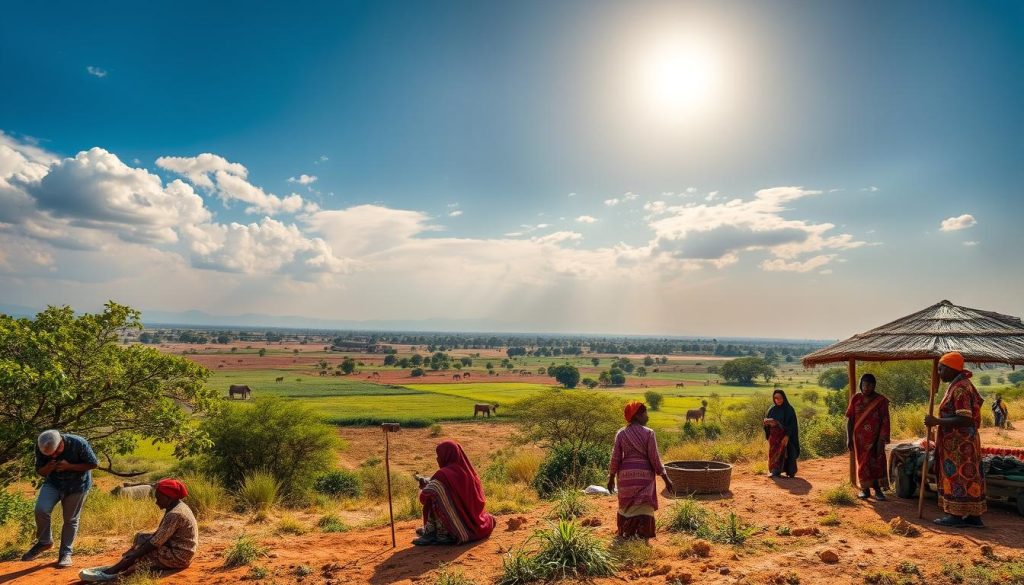
- Afro-Asiatic Language Family
- Niger-Congo Language Family
- Nilo-Saharan Language Family
In these families, you’ll find languages like Sara, Ngama, and Mbaye. These languages carry cultural knowledge and ethnic identity.
“Language is the roadmap of a culture. It tells you where its people come from and where they are going.” – Rita Mae Brown
Each language family has its own unique landscape. The Afro-Asiatic family has about 375 languages and 300 million speakers. The Nilo-Saharan family has over 100 languages. The Niger-Congo family is the largest, with 1,400 languages and 85% of African speakers.
In Chad, these languages are more than just ways to talk. They show the country’s social fabric, history, and cultural interactions over centuries.
- Sara language: Prominent in southern Chad
- Ngama language: Represents specific ethnic group traditions
- Mbaye language: Another crucial indigenous communication system
Learning these African languages helps us understand Chad’s social dynamics, ethnic diversity, and cultural richness.
The Sara Language Group and Its Significance
Chad’s language scene is rich and diverse, with the Sara language group being a key cultural gem. It has about 2,000,000 native speakers. This group’s languages are alive and vibrant, found across many regions and communities.
The Sara language family is complex and deeply rooted in Central African culture. It falls under the Central Sudanic language family. This offers a unique look into the area’s communication history.
Dialectal Variations
The Sara languages are incredibly diverse, with three main groups:
- West Sara
- Central Sara
- East Sara
Ngambay, with about 1,000,000 speakers, is the most widespread. It acts as a key link between different groups.
Geographic Distribution
Sara languages mainly thrive in certain areas of Chad, such as:
- Moyen-Chari
- Logone Oriental
- Logone Occidental
- Parts of Tandjile
Cultural Importance
The Sara languages are more than just a way to communicate. They hold deep cultural significance. With Sara people making up about 30.5% of Chad’s population, these languages are vital for keeping traditions alive and fostering community bonds.
“Language is the roadmap of a culture. It tells you where its people come from and where they are going.” – Rita Mae Brown
From Sar (Sara Madjingay) being a common language in Sarh to the varied dialects across communities, the Sara language group is a strong symbol of Chad’s cultural and linguistic richness.
Education and Language Policy in Chad
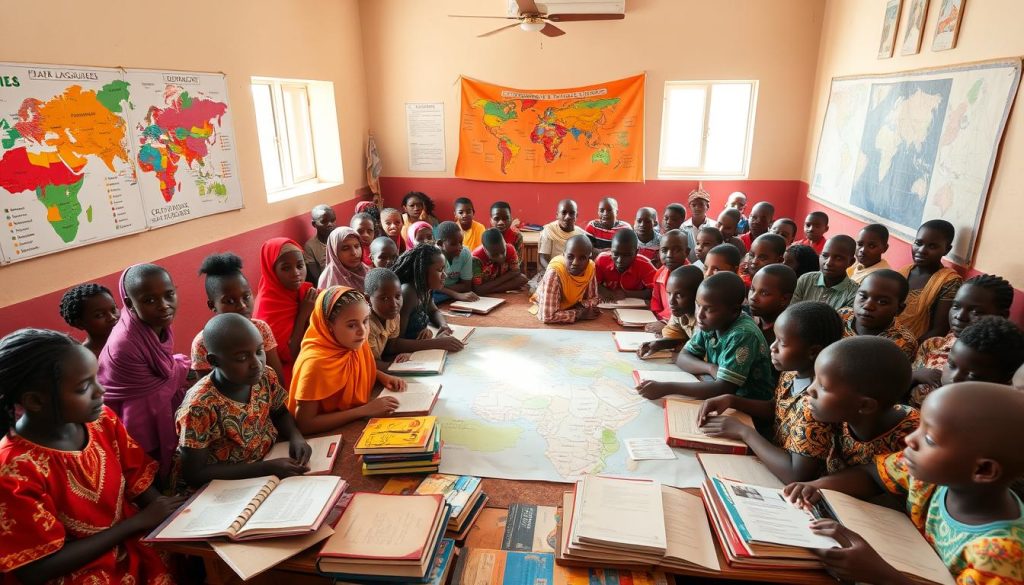
Chad’s education system faces big challenges with languages. French is the main teaching language, but many students speak African languages at home.
Key features of Chad’s education include:
- Compulsory education with big attendance issues
- Low school completion rates
- Many language barriers in education
Recent data shows important facts about Chad’s education:
- Only 68% of boys go to school after primary
- More than 50% of people can’t read or write
- The University of N’Djamena is the main place for higher education
“Language is the roadmap of a culture. It tells you where its people come from and where they are going.” – Rita Mae Brown
Chad’s many languages make education hard. French is the official language, but Arabic and African languages add to the mix. Students find it tough to learn in a language not their own.
There are efforts to solve these problems. Plans include teaching in multiple languages and keeping African languages alive in schools. The aim is to make education welcoming and valuable for all, honoring Chad’s language diversity.
Despite the hurdles, there’s a growing understanding of language’s role in education. New projects are starting to help bridge language gaps and make education more accessible for every Chadian child.
Chad: Official and Widely Spoken Languages
Exploring Chad’s languages reveals a rich cultural heritage. This country is known for its many languages, showing the diversity of its people. These languages shape how people interact and define their national identity.
Statistical Overview of Languages
Chad’s language scene is complex, with interesting facts:
- Two official languages: French and Modern Standard Arabic
- Over 120 indigenous African languages spoken nationwide
- Chadian Arabic is spoken by 40-60% of the population
Language Usage Patterns
In Chad, language use is quite interesting. French is common in cities like N’Djamena and schools. But, in rural areas, indigenous languages are more prevalent.
“Language is the roadmap of a culture. It tells you where its people come from and where they are going.” – Rita Mae Brown
Social Impact of Languages
In Chad, languages are more than just a way to talk. They connect different ethnic groups. The mix of French, Arabic, and local languages shapes society, affecting education and jobs.
- Ngambay: Most spoken first language (approximately 1 million speakers)
- Urban areas: Predominantly French-speaking
- Rural regions: Rich in indigenous language diversity
Chad’s language complexity shows its cultural richness and social ties.
Urban vs Rural Language Distribution
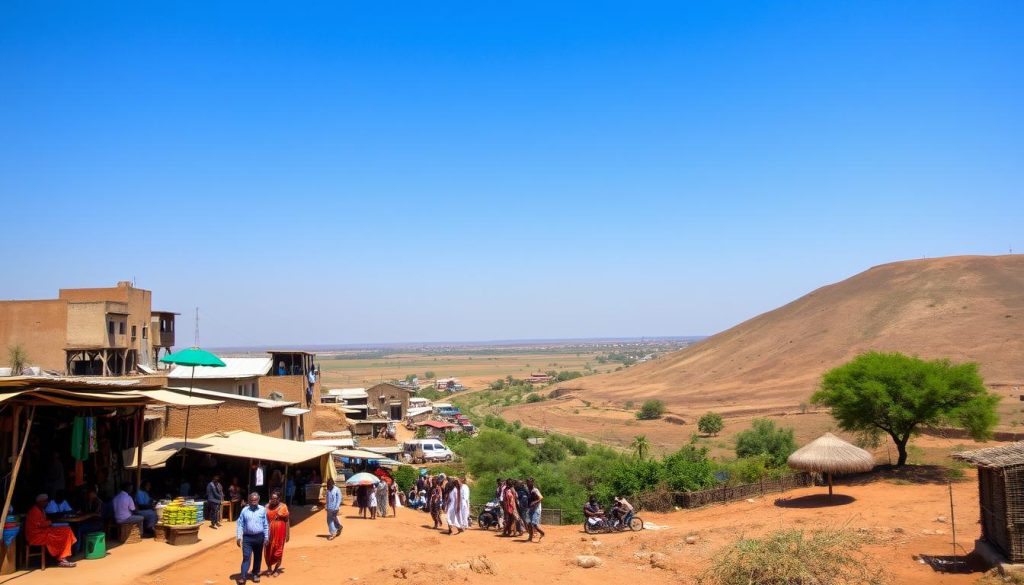
Chad’s language scene shows interesting contrasts between cities and countryside. In big cities like N’Djamena, French and Arabic are key. But in rural areas, many indigenous African languages are spoken.
In cities, a mix of languages is common. Chadian Arabic is the main way people talk in places like:
- N’Djamena (capital)
- Am Timan
- Mao
- Abéché
In the countryside, the story is different. Ethnic diversity is key to keeping languages alive. The Sara language group, with 30.5% of the population, is very important in rural areas.
“Language is the road map of a culture. It tells you where its people come from and where they are going.” – Rita Mae Brown
Urban areas have more French speakers, thanks to schools and jobs. But in rural areas, local African languages are the norm. They show deep cultural roots.
| Language Category | Urban Usage | Rural Usage |
|---|---|---|
| French | High proficiency | Limited usage |
| Chadian Arabic | Primary communication | Moderate usage |
| Indigenous Languages | Declining | Predominant |
Knowing about these language differences helps us see Chad’s rich culture. Language is a strong sign of who we are and how we connect with others.
Language Preservation Efforts
Chad’s language scene is a colorful mix of African tongues that need careful care. The country’s many languages face big challenges in keeping their cultural roots alive.
Government Initiatives
The Chadian government knows how vital it is to save native languages. They’re taking steps like:
- Starting school programs to teach local languages
- Creating rules to help document and boost minority tongues
- Backing research and projects to save languages
Community-Driven Language Documentation
Local groups are key in saving languages. The Barayin language community is a great example. They’ve come up with creative ways to keep their language alive:
- Starting a language group in 2009
- Releasing the first Barayin reading book in 2011
- Starting preschools to teach kids their native tongue
- Running adult literacy classes
“Language is the roadmap of a culture. It tells you where its people come from and where they are going.” – Rita Mae Brown
Documentation Projects
Groups like the Endangered Languages Documentation Programme (ELDP) help Chad save its languages. In 2017, they gave a grant to the Barayin community. This allowed them to record cultural elements like stories, songs, and important life moments.
These joint efforts help Chad’s rich language diversity live on. They protect the special cultural identities found in its languages for future generations.
The Role of Languages in Chad’s Business and Commerce
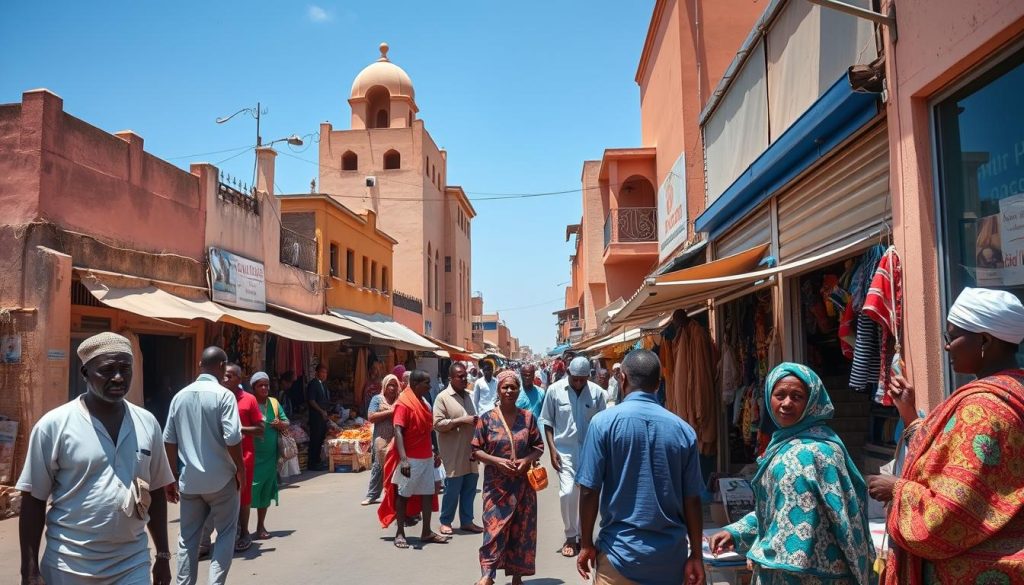
In Chad, languages are key in business talks. The country’s many languages bring both challenges and chances for business people.
Chadian Arabic is the main language for talking across different groups. It’s spoken by 40-60% of people. It’s the main language in local markets and trade.
- French is key for official business talks
- Arabic is big in local market deals
- Knowing many languages helps a lot in jobs
For international business, French is very important. It’s used for official papers, ads, and talks with other countries. Big companies mostly talk in French.
“Language is the roadmap of a culture. It tells you where its people come from and where they are going.” – Rita Mae Brown
The mobile phone world in Chad shows the country’s language mix. With 40.2% of people using mobiles, businesses use many languages to reach more customers. Internet and mobile services now support both French and Arabic.
Knowing languages can really help your business in Chad. Being good at French, Arabic, and local languages can lead to jobs in oil, farming, and digital fields.
Language Demographics and Social Identity
Chad is a multilingual society where language shows cultural identity. Over 100 languages are spoken, showing Chad’s rich diversity.
The language groups in Chad make up a fascinating mosaic. African languages are key in social interactions and culture. Ngambay is a major language, with about one million speakers.
- Total languages spoken: Over 100
- Major language families:
- Nilo-Saharan
- Afro-Asiatic
- Niger-Congo
- Dominant first-language group: Ngambay
“Language is the road map of a culture. It tells you where its people come from and where they are going.” – Rita Mae Brown
Knowing Chad’s language demographics helps us understand its social identity. Each language group adds unique cultural touches. This makes Chad’s society vibrant and connected.
| Language Family | Estimated Languages | Geographical Spread |
|---|---|---|
| Nilo-Saharan | 40-50 languages | Northern and Central Chad |
| Afro-Asiatic | 20-30 languages | Northern regions |
| Niger-Congo | 30-40 languages | Southern Chad |
Chad shows how languages can bring people together. It shows how languages can define a nation’s identity, beyond ethnic lines.
Conclusion
Exploring Chad’s language scene shows a rich and diverse society. The country has over 120 native languages and two official ones, French and Arabic. This makes Chad a standout in African language variety.
The use of Chadian Arabic as a common language shows how languages grow to unite people. It’s spoken by about 2 million people across different areas. French, mainly used in cities, works alongside native languages, making communication lively and useful for daily life.
Looking into Chad’s language world is more than just talking. It’s about the strength of culture, adaptation, and identity. By learning about these languages, we see how they influence social life, education, and community in Chad. Keeping these languages alive is key to preserving Chad’s cultural wealth for the future.
Chad’s language diversity is a big asset as the country grows. The mix of official and native languages creates a unique social structure. This structure reflects Chad’s history and its bright future. Valuing this language heritage is vital for Chad’s ongoing social and economic growth.
The above is subject to change.
Check back often to TRAVEL.COM for the latest travel tips and deals.
Here are some Tours & Sightseeing suggestions that might pique your interests!
